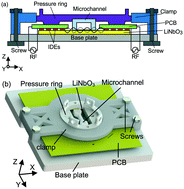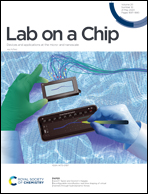Development and characterisation of acoustofluidic devices using detachable electrodes made from PCB†
Abstract
Acoustofluidics has been increasingly applied in biology, medicine and chemistry due to its versatility in manipulating fluids, cells and nano-/micro-particles. In this paper, we develop a novel and simple technology to fabricate a surface acoustic wave (SAW)-based acoustofluidic device by clamping electrodes made using a printed circuit board (PCB) with a piezoelectric substrate. The PCB-based SAW (PCB-SAW) device is systematically characterised and benchmarked with a SAW device made using the conventional photolithography process with the same specifications. Microparticle manipulations such as streaming in droplets and patterning in microchannels were demonstrated in the PCB-SAW device. In addition, the PCB-SAW device was applied as an acoustic tweezer to pattern lung cancer cells to form three or four traces inside the microchannel in a controllable manner. Cell viability of ∼97% was achieved after acoustic manipulation using the PCB-SAW device, which proved its ability as a suitable tool for acoustophoretic applications.



 Please wait while we load your content...
Please wait while we load your content...